|
|
|
Friday, May 22nd, 2009 [ versión español ]
The University of Puerto Rico at Mayagüez (UPRM) opened the clean room of micro and nano devices, the first research laboratory in Puerto Rico that has the technology to create devices so small that they are equivalent to a hundredth part of the diameter of a human hair.
The announcement was made by the multidisciplinary team of researchers and professors from UPRM made up of doctors Nelson Sepúlveda and Rafael Rodríguez, of the Department of Electrical Engineering; Rubén Díaz, of Mechanical Engineering; Agnes Padovani, of General Engineering; and Félix Fernández, of the Department of Physics.
The opening took place this past Friday, May 15, 2009 right after a press conference was held with the participation of doctors Jorge Iván Vélez Arocho, UPRM chancellor; Ramón Vázquez, dean of the College of Engineering; and Leonardo Flores, associate dean of Assessment and Learning Technology of the College of Arts, who was representing the dean of the aforementioned College, doctor Moisés Orengo.
“The clean room of micro and nano devices that is opening today is the sole installation of its kind in Puerto Rico. It will serve as a launching platform for new research initiatives and development as well as strengthen industry investments in Puerto Rico,” said UPRM Chancellor at the same time he emphasized that it’s about a field with great possibilities for the future.
Doctor Sepúlveda, principal investigator on the project, explained the relevance of the new installations and the clean room equipment, for which they received a subsidy of over $450 thousand from the National Science Foundation (NSF) as well as funds from the Central Administration of the University of Puerto Rico (UPR) for $75 thousand.
“To get an idea of the range of sizes that we are talking about, if you take a thread of hair and you look at it in a transversal way, the diameter of the hair measures 100 micrometers. We are going to have the abilities to make patterns, designs and devices with the dimension of one hundredth of a part of a human hair or one thousandth of a millimeter,” explained Sepúlveda.
The professor added that this is the first time that Puerto Rico has the necessary space and equipment to make devices of this size, which entails a series of special measures in order to guarantee their sharpness.
“To be able to work with this range of dimensions it’s necessary to have an environment in which the number of particles in the air is controlled,” explained Sepúlveda.
Tiny Inventions
Doctor Díaz explained that some examples of these devices in the manufacturing industry are chips from computers, telephones, ink cartridges for printers, and sensors for air bags in automobiles.
“With this technology we are going to make these kinds of structures here in Mayagüez, in Puerto Rico, to educate and teach students how to manufacture and carry out processes on this scale. To achieve this it’s necessary to acquire new teams and technology, which are commonly known in the majority of the universities in the United States. Today we bring them to Puerto Rico,” stated Díaz.
In the research environment, some applications that will be developed will be related to sensor devices and actuators as well as other innovative projects, for example, obtaining a diagnosis with only one drop of blood in place of a tube of blood.
He added that this process is known as Lab-on-a-chip. This innovative project proposes to eliminate the long period of waiting for blood results as well as the large quantity of blood that is extracted in order to get these results.
“When you work with such small scales you can measure ranges of temperature and pressure with such precision which you cannot do with larger devices. In other words, not only does it improve energy consumption but it also significantly raises the resolution of these measurements. With these micro devices they have been able to measure pressure changes so small such as the difference in pressure between the first and second floor of a house, due to atmospheric pressure,” explained Sepúlveda.
Multiple Disciplines United in a Huge Deed
The principal researcher emphasized the multidisciplinary character of the project, which is evident in the diverse academic areas of its members and which unites several of the Departments of Engineering with the Department of Physics from the College of Arts and Sciences.
In fact, as indicated by Sepúlveda and Díaz, the quality of this project motivated them to bring this type of technology to the Island, while they carried out graduate studies in the United States.
“We noticed that in Puerto Rico we didn’t have a laboratory to manufacture these micro devices that could be used in a variety of disciplines,” commented the Sepúlveda, who added that once they had returned to their teaching positions, they began the task of gathering his colleagues and composing this ambitious proposal.
The professors emphasized that the principal purpose is to contribute to the field of education and scientific research, in which the clean room, located in the Center of Research and Development (CID, by its Spanish acronym) building, will be open to undergraduate students as part of various academic courses and for graduate students that form part of a research project.
In the Dean of Engineering’s judgment, this is the project’s greatest achievement. “This opening ends the cycle in which we have tried to have a center with this type of technology that goes from creation to application,” explained Vásquez.
Doctor Rajinder Khosla, Director of the Division of Computer and Network Systems of the NSF, attended the opening of the clean room at UPRM.
“One of the reasons this campus got the approval for this award was because people felt in the panel that it would be a good thing since UPRM offers all of the branches of Engineering. This will be helpful to start the facility and maybe get additional funds to expand it. I am glad that the facility is set up and that you are working with this technology, which is the future,” he commented.
Researchers foresee that this gesture will open the doors for the technological development with the capacity of commercialization. They observed that many companies collaborate with universities in order to achieve advances in the development of new technologies as well as in science that are needed to better understand the same. In this way both institutions will benefit.
Video
Verify that your navegator can ejecutate javascript and that has the most recent version of Adobe Flash Player. Dowmload Flash Player
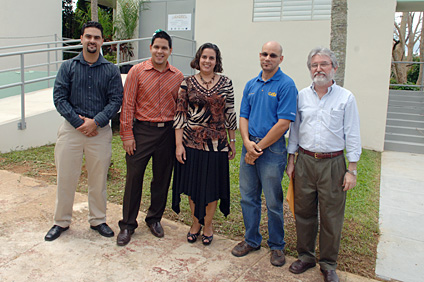
The team of researchers is made up of from the left: doctors Nelson Sepúlveda, Rubén Díaz, Agnes Padovani, Rafael Rodríguez and Félix Fernández.
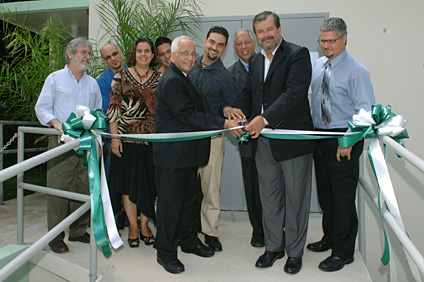
Laboratory directors, during the cutting of the ribbon for the opening of the installation. In the first row: doctors Rajinder Khosla, Nelson Sepúlveda, Ramón Vázquez, chancellor Jorge Iván Vélez Arocho and Leonardo Flores.
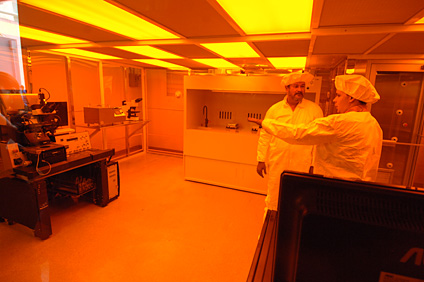
Doctor Rubén Díaz explains to UPRM Chancellor how the equipment in the clean room will be used.
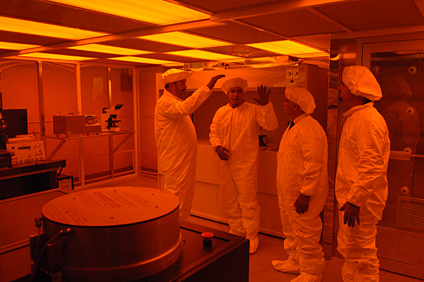
The clean room, located in the CID building, is the first research laboratory in Puerto Rico of its kind.
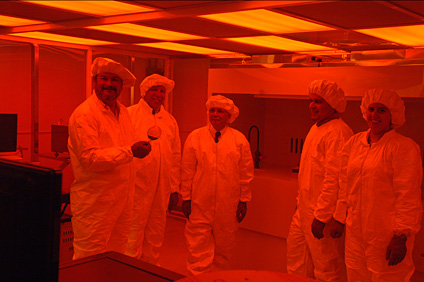
The environment for making devices of this scale entails a series of special measurements to guarantee their sharpness.
Photographs by Carlos Díaz / UPRM Press
Foro Colegial
 Laboratorio de investigación en micro y nano dispositivos Laboratorio de investigación en micro y nano dispositivos
|

